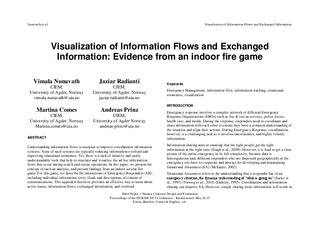Visualization of Information Flows and Exchanged Information: Evidence from an indoor fire game
| dc.contributor.author | Nunavath, Vimala | |
| dc.contributor.author | Radianti, Jaziar | |
| dc.contributor.author | Comes, Tina | |
| dc.contributor.author | Prinz, Andreas | |
| dc.date.accessioned | 2016-01-14T15:45:44Z | |
| dc.date.accessioned | 2016-01-22T11:17:39Z | |
| dc.date.available | 2016-01-14T15:45:44Z | |
| dc.date.available | 2016-01-22T11:17:39Z | |
| dc.date.issued | 2015 | |
| dc.identifier.issn | 2411-3387 | |
| dc.identifier.uri | http://hdl.handle.net/11250/2374548 | |
| dc.description | - | nb_NO |
| dc.description.abstract | Understanding information flows is essential to improve coordination information systems. Aims of such systems are typically reducing information overload and improving situational awareness. Yet, there is a lack of intuitive and easily understandable tools that help to structure and visualize the ad hoc information flows that occur during search and rescue operations. In this paper, we present the concept of such an analysis, and present findings from an indoor serious fire game. For this game, we describe the interactions of Emergency Responders (ER), including individual information (over-)load, and descriptions of content of communications. This approach therefore provides an effective way to learn about active teams, information flows, exchanged information, and overload. | nb_NO |
| dc.language.iso | eng | nb_NO |
| dc.relation.uri | http://iscram2015.uia.no/?p=1992 | |
| dc.title | Visualization of Information Flows and Exchanged Information: Evidence from an indoor fire game | nb_NO |
| dc.type | Journal article | nb_NO |
| dc.type | Peer reviewed | nb_NO |
| dc.date.updated | 2016-01-14T15:45:44Z | |
| dc.identifier.cristin | 1276736 |
